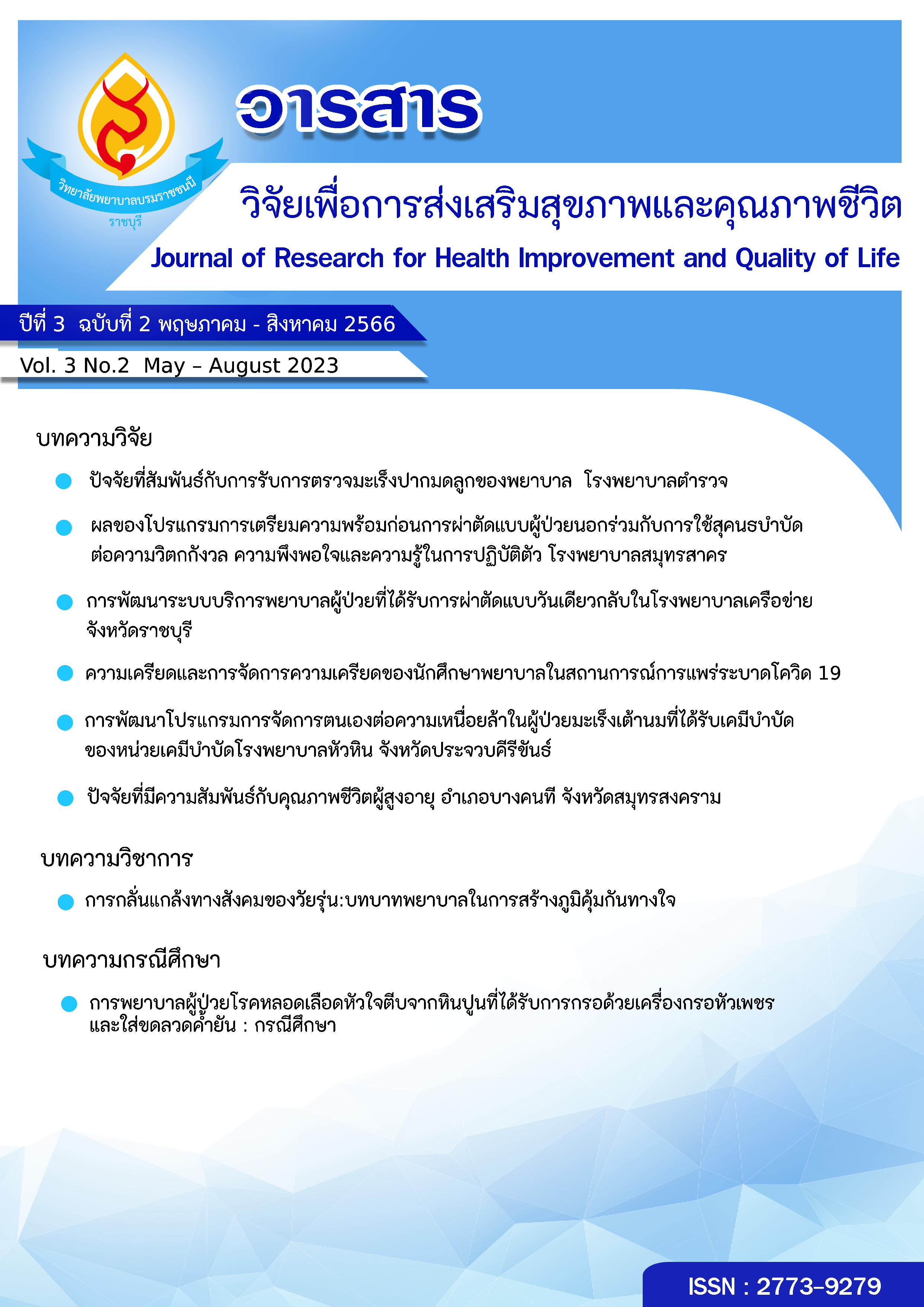การกลั่นแกล้งทางสังคมของวัยรุ่น: บทบาทพยาบาลในการสร้างภูมิคุ้มกันทางใจ
คำสำคัญ:
ภูมิคุ้มกันทางใจ , การกลั่นแกล้งทางสังคม , วัยรุ่นบทคัดย่อ
ปัจจุบันพฤติกรรมการกลั่นแกล้งทางสังคมยังเป็นประเด็นปัญหาที่ไม่ควรถูกมองไป โดยเฉพาะการกลั่นแกล้งในกลุ่มวัยรุ่น ในยุคที่สังคมกำลังเข้าสู่ยุคดิจิทัลทำให้วัยรุ่นสามารถเข้าถึงเครื่องมือสื่อสารและช่องทางสื่อสารแบบออนไลน์ได้ง่ายขึ้น การกลั่นแกล้งแบบดั้งเดิมที่มีปัญหาอยู่ก่อนแล้วก็ยังคงอยู่และยังเพิ่มวิธีการกลั่นแกล้งในรูปแบบออนไลน์ขึ้นมาด้วย จะเห็นได้ว่าการกลั่นแกล้งเหล่านี้ก่อให้เกิดผลกระทบต่อผู้ถูกกระทำและผู้กระทำทั้งทางตรงและทางอ้อม อีกทั้งยังส่งผลกระทบไปจนถึงวัยผู้ใหญ่
จะเห็นได้ว่าแนวทางการป้องกันและแก้ไขปัญหาการกลั่นแกล้งทางสังคมในวัยรุ่น นั้นมีความจำเป็นอย่างยิ่งที่จะต้องสร้างความเข้มแข็งภายในจิตใจ โดยสร้างภูมิคุ้มกันทางใจให้กับวัยรุ่นโดยต้องเริ่มพัฒนาตั้งแต่วัยเด็ก ครอบครัวและโรงเรียนจะต้องให้ความใส่ใจ เข้าใจ ปลูกฝังความตระหนักรู้ในคุณค่าของตนเอง ตั้งสติเพื่อเผชิญหน้ากับปัญหาได้อย่างเหมาะสม ทั้งนี้พยาบาลยังมีบทบาทสำคัญในการส่งเสริมและป้องกันปัญหาสุขภาพจิตโดยจะต้องทำงานประสานกับโรงเรียนและครอบครัว ในการช่วยกันสร้างภูมิคุ้มกันทางใจให้วัยรุ่น
เอกสารอ้างอิง
American Psychological Association. (2022). Bullying. https://www.apa.org/topics/bullying
Ang, R. P. (2015). Adolescent cyberbullying: A review of characteristics, prevention and intervention strategies. Aggression and violent behavior, 25, 35-42.
Beran, T., Mishna, F., McInroy, L. B., & Shariff, S. (2015). Children's experiences of cyberbullying: A Canadian national study. Children & Schools, 37(4), 207-214.
Bonanno, R. A., & Hymel, S. (2013). Cyber bullying and internalizing difficulties: Above and beyond the impact of traditional forms of bullying. Journal of youth and adolescence, 42, 685-697.
Chainwong P., Skulphan S. & Thapinta D. (2020). Being Cyberbullied and suicide risk among youths. The Journal of Psychiatric Nursing and Mental Health. 30(3), 133-151.
Colino S, Broadwell L & Schuman C. (2021). How to deal with bullies: A guide for parents. https://www.parents.com/kids/problems/bullying/ bully-proof-your-child-how-to-deal-with-bullies/
Davies, K. E. (2012). A typology of family functioning in a child and adolescent outpatient community mental health treatment facility (Doctoral dissertation, University of Pittsburgh).
Department of Mental Health. (2021). What is Bully, how many types and how to cope from being bullied. https://dmh.go.th/news -dmh/view.asp?id=30612
Erikson, E. H. (1963). Childhood and society (2nd ed.). New York, Norton.
Eukeik. ee. (2021). Internet User in Thailand 2021 How many internet users in Thailand compared to the world. https://marketeeronline.co/archives/208372
Huang, C. L., Yang, S. C., & Hsieh, L. S. (2019). The cyberbullying behavior of Taiwanese adolescents in an online gaming environment. Children and Youth Services Review, 106, 104461.
Kumar, V. L., & Goldstein, M. A. (2020). Cyberbullying and adolescents. Current pediatrics reports, 8, 86-92.
Leon Vicente, I. (2016). Cybervictimization by cyberbullying: children at risk and children as risk. (dissertation). University of the Basque Country, Leioa, Spain.
Navachewinmai N., Thongnin P., Rungchareankiat D., Booncherdchoo N., & Maneera C. (2023). Self – Esteem of Early Adolescent for Coping with Cyber Bullying. Academic Journal of Phetchaburi Rajabhat University, 13(1), 144-157.
Sanit R. (2022). Marketers must know Kids now use social media the most. You tube leads the way TikTok is hot , Facebook is down https://brandinside.asia/teen-and-social-media-survey-2022/
Statista. (2021). U.S. internet users who have experienced cyber bullying 2020. https://www.statista.com/statistics/333942/us-internet-online-harassment-severity/
Smith, P. K., Mahdavi, J., Carvalho, M., Fisher, S., Russell, S., & Tippett, N. (2008). Cyberbullying: Its nature and impact in secondary school pupils. Journal of child psychology and psychiatry, 49(4), 376-385.
Thomas, H. J., Connor, J. P., & Scott, J. G. (2015). Integrating traditional bullying and cyberbullying: challenges of definition and measurement in adolescents–a review. Educational psychology review, 27, 135-152.
Tumsen T. (2551). Activity to enhance mental immunity for youth in the community. Journal of Srithanya Hospital, 9(1), 83-86.
Unicef. (2017). Children in a digital world. United Nations Children's Fund (UNICEF).
Yen, C. F., Yang, P., Wang, P. W., Lin, H. C., Liu, T. L., Wu, Y. Y., & Tang, T. C. (2014). Association between school bullying levels/types and mental health problems among Taiwanese adolescents. Comprehensive psychiatry, 55(3), 405-413.
Yuvabadhana Foundation. (2019). Bully, Social Violence. Bangkok: Yuvabadhana Foundation. https://www.yuvabadhana foundation.org/th87-bullying-%E0%B8%A7%.
ดาวน์โหลด
เผยแพร่แล้ว
ฉบับ
ประเภทบทความ
สัญญาอนุญาต
ลิขสิทธิ์ (c) 2023 วิทยาลัยพยาบาลบรมราชชนนี ราชบุรี

อนุญาตภายใต้เงื่อนไข Creative Commons Attribution-NonCommercial-NoDerivatives 4.0 International License.
บทความทีตีพิมพ์ในวารสารนี้ถือว่าเป็นลิขสิทธิ์ของวิทยาลัยพยาบาลบรมราชชนนี ราชบุรี และผลงานวิชาการหรือวิจัยของคณะผู้เขียน ไม่ใช่ความคิดเห็นของบรรณาธิการหรือผู้จัดทํา




